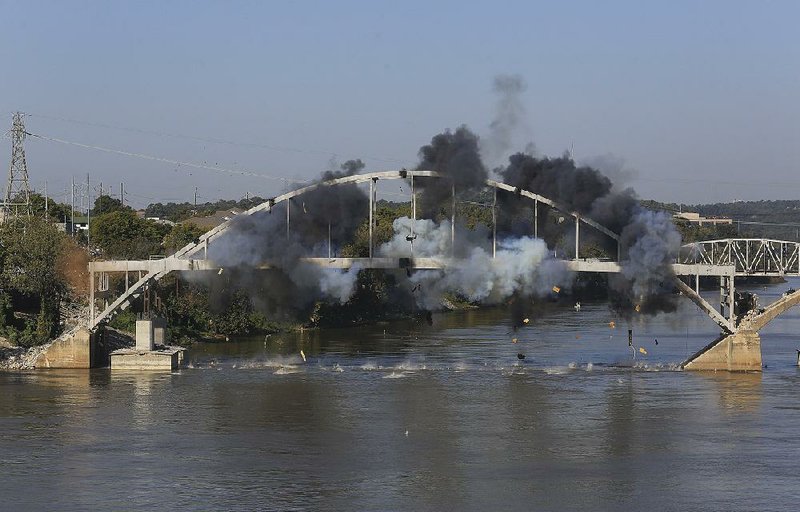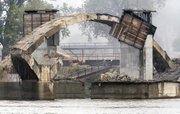Blowing up a concrete and steel bridge in a heavily developed, densely populated area is a lot more difficult than it looks, says Paul Scharmer, who works for a company that blows up a lot of stuff.
Scharmer is vice president of operations for Massman Construction Co., which has the $98.4 million contract to replace the 93-year-old Broadway Bridge over the Arkansas River in central Arkansas.
The company has had three less-than-perfect demolition operations on the project over the past few weeks, the latest being Monday's attempt to raze a concrete footing in the middle of the river. Earlier attempts to bring down the old bridge's steel arch and a concrete arch also fell short of the blasts' intended goals.
It is one thing to blow up something "in the middle of nowhere," he said Tuesday. "If you can do it with 3 pounds [of explosives], you might use 10 just to make sure."
[BROADWAY BRIDGE: Find videos, traffic map, cameras, previous coverage, photos here]
As it is, the Broadway Bridge project is right smack in the middle of somewhere, straddling the navigable Arkansas River between the hustle of downtown Little Rock and the bustle of downtown North Little Rock.
Engineering the demolitions has required balancing the goal of removing the bridge structure with the need to avoid damaging any nearby structures, Scharmer said.
Think of it as threading a needle ... with thousands of pounds of explosives.
In the case of the concrete footing on Monday, it was 40 feet from the end of an arch for the new bridge that was floated into place last week, meaning the explosives had to remove the footing without damaging the new arch.
"We're walking a fine line" in a field -- explosives and demolition -- that is an "inexact science," Scharmer said.
Scharmer's comment came as Massman workers and the company's demolition contractor were still trying to figure out why 3,500 pounds of explosives failed to fully destroy the large concrete pier footing, which forced the company to postpone Tuesday's plan to float the second and final arch of the new bridge into place.
"The intact remains of the detonated structure are high enough to prevent Massman from sinking staging barges [supporting the new arch] low enough into the river for final placement on concrete piers," the Arkansas Highway and Transportation Department said in a statement. "Additionally, the remains sit in what will become part of the new, wider navigation channel under the bridge."
Massman officials are unsure whether all of the explosives used for the blast actually exploded or whether not enough explosives were placed, Scharmer said. Another possibility is that the remaining structure is just a large pile of rubble, he said.
As for the old steel arch, which withstood explosives and had to be pulled down Oct. 11, it was close to Robinson Center, which recently underwent a $70 million renovation and features, among other things, a large bank of glass windows facing the river.
Engineers ran models to estimate the sound wave that would be generated by the explosions to ensure they weren't powerful enough to damage any of the Robinson Center's new windows, Scharmer said.
"It's a balancing act," he said.
Neither the steel arch nor the concrete footing was part of the old bridge when it was built in 1922. They were added in the 1970s to accommodate the McClelland-Kerr Arkansas River Navigation System.
Assisting Massman in the demolition is Engineered Explosive Services of San Antonio, which Scharmer said Massman has used on other projects.
None of the additional work necessitated by the imperfect blasting has added any costs that taxpayers will have to bear, according to a department spokesman.
The delay also is "not a major hurdle in our efforts to get the bridge open," said Scharmer, who said the second arch likely will be floated into place next week.
Further, he said, no one has been hurt nor any other property damaged by the blasts.
"We wanted to explode it successfully, but that is certainly what's more important," he said. "There might be some damage to our reputation, but that's not something we worry about."
Ron Elliott, president of International Blasting Consultants Ltd. of Coquitlam, British Columbia, who has more than 22 years of demolition experience, said demolition projects become vastly more complicated when they are in the water.
"Taking down steel structures with explosives and blasting of bridge piers are challenging projects requiring much advanced planning, test blasting, use of highly experienced blasters, and often involves input from a structural engineer into the design of the shots," Elliott said.
Metro on 11/23/2016


